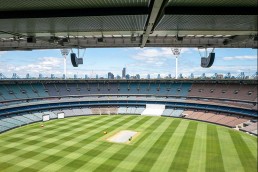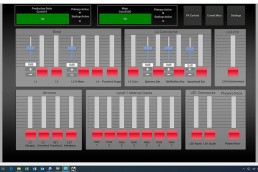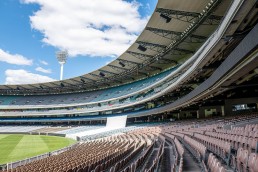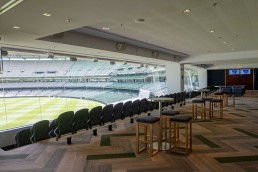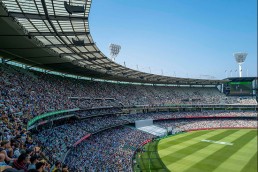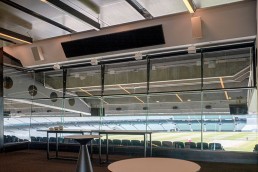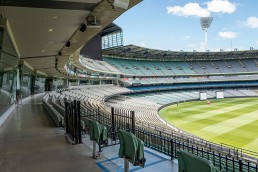This website uses cookies so that we can provide you with the best user experience possible. Cookie information is stored in your browser and performs functions such as recognising you when you return to our website and helping our team to understand which sections of the website you find most interesting and useful.
Melbourne Cricket Ground
ProjectMelbourne Cricket GroundLocationMelbourne, Victoria, AustraliaManufacturers d&b, QSC, DiGiCoDistributorNational Audio Systems, Melbourne. Technical Audio Group, Sydney. Group Technologies, Melbourne.InstallerRutledge AV - A Diversified CompanyAcousticianAuditoria Pty LtdInterior DesignerAuditoria Pty Ltd
The project was a complete refurbishment of the audio systems throughout the MCG including the bowl, concourses, corporate areas, gates, media areas and the many bars and restaurants in the massive 100,000-seat stadium.
Our design used d&b Vi and Yi series loudspeaker arrays with array processing for the bowl. The lower bowl consisted of 15 arrays of 8 Vi8 elements with the upper bowl consisting of 29 arrays of Yi8 in various lengths depending on coverage requirements. Each of the Yi arrays also had a bass array of 3 Vi-Sub elements. The total count was 120 Vi8, 248 Yi8, 30 Yi10P for delays, 84 Vi-Sub and 13 27S-Sub on 100 30D’s and 20 D80’s.
The under-balcony and concourse areas at the MCG are huge and full bandwidth delay systems were provided consisting of 1,299 d&b loudspeakers and 80 subs including E8, E6, E12-D, 24C, 10S-D, 8S, 5S and 27S-Subs on over 120 10D and 30D amplifiers. In addition, we used over 600 QSC AD-series loudspeakers in low-ceiling corridors and other concourse areas.
There are 57 bars and function rooms within the stadium, some small but most area large spaces. Our goal was to provide high quality sound in the rooms for the program content but also provide the atmosphere of the seating bowl. We used 20 audience microphones distributed around the stadium and mixed in Q-SYS to provide a crowd feed into each area that is controlled with a local Q-SYS touch panel. We used over 600 loudspeakers from d&b and QSC throughout the bar and function spaces.
QSC Q-SYS was used for the DSP, signal transport and user interfaces for all bars, restaurants and function areas. DiGiCo 4REA4 engines and an SD9 is used for bowl mixing. The QSC interface allows the system to be configured to suit the capacity for each event including crowd mic presets, loudspeaker mutes, Array Processing presets to suit the weather conditions and switching between SD9 control or basic control from AControl8 fader panels.
The MCG was in full operations throughout the whole installation period with multiple functions, events and games on every week. The coordination and project management of the works to maintain a fully working audio system at all times throughout this period and to avoid disruption of events was a significant challenge. This also had an impact when installing the main arrays as the field was available for just a few weeks and the turf required specialised protection. Cranes were only allowed to stay on the field for a very limited time (a few hours in some cases) as the turf protection had to be removed to ensure that the turf was not damaged.
A big challenge was that some of the products used had never been deployed in such a large scale. For example, the number of amplifiers and loudspeakers are a first for the controller software. Having a single loudspeaker per amplifier channel in each array gave us great flexibility but it meant that the software load increased. Navigating the software and control at a scale that had never been tested proved to be a challenge and methods and optimisation in our commissioning process had to be developed on site.
Our aim of providing a consistent experience to all patrons meant that our commissioning process had to be well documented and repeatable. This is a challenge in a 100,000-seat stadium with two very different stands and several levels. Our measurement and optimisation process required time and effort as every area was measured and verified to ensure that our aim was met.
And generally, what are routine operations become challenges in a project of this scale. For example, correcting the aim of a loudspeaker becomes a real challenge when hundreds and hundreds of loudspeakers are to be verified and aimed. Similarly, verifying control for user interfaces becomes a challenge when dozens of rooms need to be verified for correct operation.
Historically, installed sound systems in stadia have focused on clear speech reproduction. It’s rare that high quality reproduction for full range music or content is sought in a stadium environment. Delivering high performance sound in such large venues with tricky acoustics is an expensive and complex exercise.
The Melbourne Cricket Club (MCC), the owners of the MCG, are focused on delivering the best they can to every element of the audience experience. In terms of the sound, they made it clear that providing an excellent quality experience of the game-day was the primary goal of this upgrade project. From entertainment packages, commentary, video packages and on-field interviews, as well as ensuring the fans can remain engaged in the event throughout their entire journey in the stadium, we quickly had a clear understanding of the expectations of the project.
To meet this expectation, we drew on our unique experience in designing audio systems for multiple Olympic Ceremonies over the last 15 years to guide our design process. The commitment to quality is evident in the use of ArrayProcessing technology in all loudspeaker arrays and 87 cardioid subwoofers in the seating bowl, to the inclusion of 80 cardioid subwoofers in the under-balcony areas to deliver full bandwidth sound to every corner of the stadium. In our experience we have not encountered a stadium installation worldwide that delivers this level of sound quality and performance.
The commitment to quality is further emphasised in the design approach to the function rooms and bars to keep the audience engaged with the game. Our crowd mic system uses 20 mid-side microphones distributed around the stadium with a user interface that allows the operator to adjust the pattern of each mic from hyper-cardioid (shotgun) to a figure-8 to suit the audience capacity and crowd distribution. This mix is then distributed through the stadium via Q-SYS and can be adjusted in level by the bar staff as needed.
In the end, the large quantities of equipment are necessary for a space of this magnitude but also to achieve the level of quality that is hard to rival.
